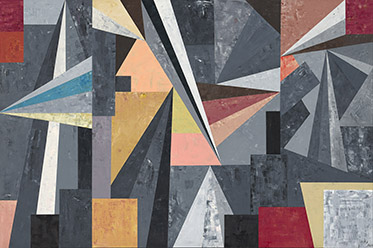 The first large-scale retrospective exhibition of Robert Jacks – one of Australia’s most significant and accomplished abstract artists, will be presented at the National Gallery of Victoria from 3 October 2014.
The first large-scale retrospective exhibition of Robert Jacks – one of Australia’s most significant and accomplished abstract artists, will be presented at the National Gallery of Victoria from 3 October 2014.
From his first sell-out solo exhibition at Gallery A in Melbourne in 1966, through to his ongoing exploration of abstraction in painting, sculpture, drawing and printmaking, Jacks’ work has charted a distinctive and influential path through late twentieth and early twenty-first century Australian art.
Robert Jacks: Order & Variation will present more than two hundred works which span his entire career, from the minimal and conceptual works produced during his time in the United States, to his monumental late paintings and sculptures.
“Robert Jacks was a pioneering figure of Australian abstractionism whose example has offered an alternative path to subsequent generations of Australian artists,” said Tony Ellwood, Director, NGV. “We are honoured to present the first retrospective of Jacks’s work, while recognising the deep and lasting influence he has had upon the field of Australian art.”
Born in Melbourne, Robert Jacks [1943-2014] studied sculpture at Prahran Technical College from 1958-1960 and painting at RMIT from 1961-1962. His debut solo exhibition was held to great acclaim in 1966. The show was a sell-out, with the largest and most significant work, Timbrel and harp soothe 1965, being acquired by the National Gallery of Victoria. The works featured in the exhibition displayed how Jacks was contemplating different possibilities for a new Australian abstraction and subsequently launched his artistic career.
This exhibition coincided with the end of the dominance of figurative expressionist painting in Australia and a move by Jacks and many of his contemporaries to a new style of abstraction broadly referred to as ‘Colour Field’ painting. In 1968, Jacks’s work, Red painting 1968 was included in The Field, the landmark exhibition which launched the new National Gallery of Victoria building.
In early 1968 Jacks left Melbourne for Toronto and spent the next decade living and working in Canada and the United States. He settled in New York in 1969, and it was while living in the thick of the city’s downtown arts scene that his unique visual language matured, incorporating influences from the major exponents of contemporary abstraction, minimalism and conceptual practice.
An active participant in the New York art scene, Jacks mixed with such artistic luminaries as Sol Le Witt and Donald Judd. As one of very few Australian artists who experienced Minimalism and conceptual practices at their source, Jacks’ influence on subsequent generations of artists was significant both as a teacher and mentor. It was also this experience which made him a unique figure within the history and development of twentieth century Australian art.
After a period living in Texas in the late 1970s Jacks was invited to take up a position as artist in residence at the University of Melbourne in 1978. He subsequently held positions as a lecturer at the Sydney College of the Arts in 1980 and at Prahran College where he lectured in painting from 1984-88.
Jacks’ art has continually played with a certain degree of order and variation, and his earlier work has always been a constant source of inspiration for his current practice. He often worked across various mediums simultaneously, exploring the possibilities of an idea in two and three dimensions, and in materials as diverse as watercolour on paper, paint on canvas and serial shapes cut into rubber, felt and paper.
Robert Jacks: Order & Variation
The Ian Potter Centre: NGV Australia, Federation Square, Melbourne
Exhibition: 3 October 2014 – 15 February 2015
Free entry
For more information, visit: www.ngv.vic.gov.au for details.
Image: Robert Jacks, Australia 1943–2014 Acuminated granite 1984–85, oil on canvas, 198.0 x 298.0 cm, Estate of the artist, Victoria © Robert Jacks
